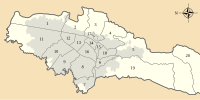Bosa, Bogotá
Bosa | |
|---|---|
UTC-5 (Colombia Standard Time) | |
| Website | Official website |
Bosa is the 7th locality of the Capital District of the Colombian capital, Bogotá. Bosa is located in the southwest of Bogotá and is the 8th largest locality and 9th most populated. This district is inhabited by working-class residents.
Etymology
The name of Bosa in Muysccubun means "enclosure of the one that guards and defends the cornfields".[2]
Geography
Bosa limits to the north with the Tunjuelo River and the Camino de Osorio neighborhood of the locality Kennedy. To the south Bosa borders the Autopista Sur separating it from the localitity of Ciudad Bolívar and the municipality of Soacha in Cundinamarca. To the east, Bosa borders the Tunjuelo River and the locality of Kennedy and to the west the Bogotá River and the municipalities of Soacha and Mosquera.
Besides being crossed by the Tunjuelo and Bogotá River, Bosa also has numerous creeks and streams which include the Quebrada Limas, Quebrada Trompeta, La Estrella, El Infierno, Quiba, Calderón, Bebedero and Aguas Calientes.
History

Bosa was once the site of an important
Early in 1538, Bosa witnessed one of the most dramatic chapters in the history of the
In 1538, Bosa became a meeting place for Gonzalo Jiménez de Quesada, Nikolaus Federmann and Sebastián de Belalcázar during the Spanish conquest of the Muisca. The exact location of their encounter was marked with a stone cross, today located on the east side of Bosa's main square.
The 4th article of the June 22, 1850 Law dissolved the
On November 22, 1853, a battle took place in Bosa between the forces of
Until the mid 20th century, Bosa was a relatively small municipality formed by five neighborhoods and a population less than 20,000 people. The people dedicated to rural agricultural activities. By 1954, the government of
In the Colombian Constitution of 1991, Bogotá was rearranged and became the Capital District in which Bosa formed the 7th locality. In 1992 and 2000, the Cabildos of Suba and Bosa were officially recognized by the Government of Bogotá as stipulated in Law 89 of 1890. The Cabildo Mayor del Pueblo Muisca was founded on September 22, 2002 in Bosa.
Sites of interest
- San Bernardino Church, the construction of this church began in 1618 and was declared a National Monument by the Colombian government. In front of it a stone cross marks the exact place where the three conquistadors met.
- El Humilladero Hermitage
- Francisco de Paula Santander School. It is a school located in next to the Town hall of Bosa, is recognized as the first school of Bosa, its creation and inauguration was in 1938 as a rural school, now "La Casona" is a cultural heritage being a structure on the verge of collapse, but it is composed of other buildings where classes are taught for all grades.[3] Currently has the classroom RTC (Reinvent The Classroom), which is a classroom of education 3.0, first classroom in Colombia and Latin America.[4]
Neighborhoods and veredas
Neighborhoods
- Among the most important neighborhoods are : La Libertad, Palestina, Bosa Brasil, Bosa La Independencia, Piamonte, Jiménez De Quesada, Despensa, Laureles, La Estación, La Azucena, La Amistad, El Motorista, Antonia Santos, Naranjos, Olarte, El Corzo and downtown Bosa.
Veredas
The San Bernardino vereda is inhabited by direct descendants of the Muisca who used as last name the name of the tribe, such as Neuta, Chiguasque, Tunjo, Orobajo and Fitatá.
Transport
Locally, Bosa has very few access points due to the presence of large
References
- ^ (in Spanish) Population 2007 - DANE
- ^ (in Spanish) Etymology localities of Bogotá
- ^ Historical Review-Francisco de Paula Satander School{https://www.fps.edu.co/horizonte-institucional}[permanent dead link]
- ^ Reinvent The Classroom-View 360°{https://www.fps.edu.co}[permanent dead link]


